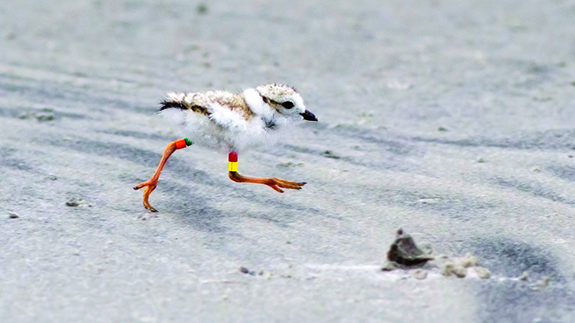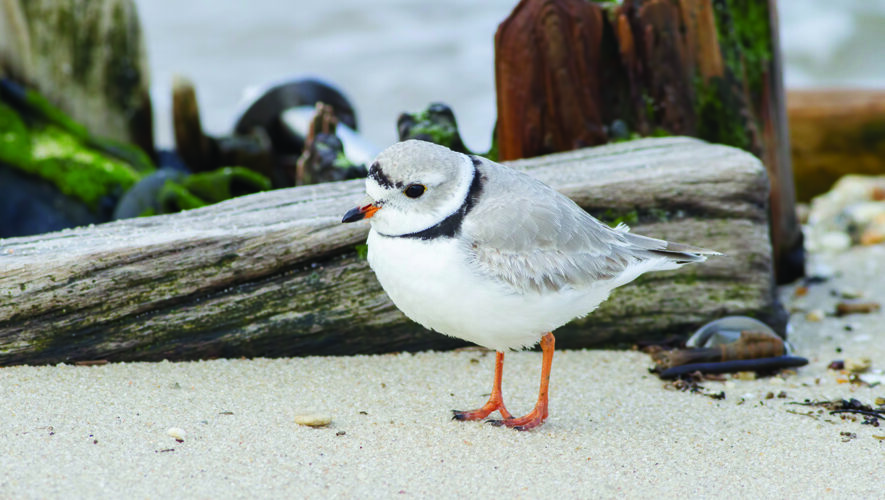Story features new life, tough odds, predators, an unfortunate end but also hope for future
OCEAN CITY — In May, Sideshow Bob and El Toro Loco created the first new piping plover nest in more than a decade on a beach in the center of Ocean City. There were high hopes for the four chicks that were born, but the odds were against them from the start.
Unfortunately there was no happy ending, but a hint at possibilities to come in the continuing struggle for this endangered species.
In the early 2000s, there were as many as eight pairs of piping plovers in the stretch of beach from 19th to 30th streets, but over time the habitat filled in. There hadn’t been a pair in that area since 2011, according to Christina “Kashi” Davis, principal zoologist with the New Jersey Department of Environmental Protection’s Division of Fishing and Wildlife Endangered and Nongame Species Program in Woodbine.
“When sites go inactive like that, we’re not actively checking. We go out during census periods in June, maybe, but that site was not on our radar whatsoever,” Davis said. “Nothing happened that usually would trigger the reactivation of a site.”
Ocean City resident Rhonda Van Wingerden called the division’s hotline in May to report a nesting pair on the 16th Street beach.
Davis was skeptical.
“Almost always when it’s a weird site or something unusual, it’s usually a killdeer that people are seeing or a semipalmated plover on migration,” Davis said, so she asked Van Wingerden to make sure.
“I have a photo but it’s kind of blurry,” she told Davis.
“I said, ‘Great, send that.’ As soon as I saw it I was like, ‘Oh no, that’s definitely piping,’” Davis said. “We sent staff out immediately to check it out and sure enough they found these two piping plovers.”
The pair was right where Van Wingerden’s family found them. Because both were banded, the division could identify them as 1-year-old chicks, one from Barnegat Light in Ocean County and the other from Corson’s Inlet at the south end of Ocean City.
Still, she was surprised.

“Why they selected that spot, we have no idea,” Davis said. “There is nothing really about that location that says, ‘Oh my gosh, 100 percent they’re going to be here. There’s still room available at Corson’s and in the north end (of Ocean City), but for whatever reason that’s where they wanted to be so there they were.
“That started us off on our adventure in Ocean City this year.”
The two birds were named Sideshow Bob and El Toro Loco.
Sideshow would not be long for this world.
Davis said the male was named for a ski slope that in turn was named for the character on “The Simpsons.” One of the women who helped band him is a skier who gave him his moniker.
“I actually named El Toro Loco after my nephew. He’s really into trucks,” Davis said. “He’s 3 years old, and (El Toro Loco) is his favorite monster truck so I named it for him.”
Alas, a fox killed Sideshow Bob. That could have spelled an early end to the story, but El Toro Loco found another mate.
“An unbanded male had been there for a week and he was definitely interested in her,” Davis said, laughing. “She already had her nest with Sideshow, but as soon as Sideshow was lost, that male moved in very quickly. He was like, ‘All right, let’s go.’
“We know El Toro Loco is 1 year old. It’s very likely that male was also a young bird. Although it’s interesting and fun to have (a nest) in the center of town, it’s not the best habitat for them,” Davis said. “We often see these younger birds in areas that are not ideal. As they get older and can hold their own and do their own territorial disputes, we often see them move to more natural areas that have a higher density of piping plovers because they can get in those fights with each other and win. When they’re 1-year-olds, they have a hard time keeping up.”
The more natural areas where piping plovers nest on the barrier island are in the north and sound ends.
The north end went through a drought as well, according to Davis, until about four years ago.
“One pair showed up at first and this year there were four pairs that nested in the north end. We had three pairs that nested in Corson’s Inlet on the state park side.”
It takes a village
Back in the center of town, four chicks hatched, but nature is not the kindest for birds that weigh the equivalent of eight pennies when they’re born, even with the community and Davis’ division on their side.
“It’s a really difficult path that they’re on, but then you have a summer like we had in Ocean City, where you get the public really rallying behind this little pair,” Davis said. “I can’t tell you the days our staff would come back and say, ‘Another great day in Ocean City,’ which is very unusual for us because our staff spends a lot of time getting yelled at by the public and people are very negative toward the birds because there are so many restrictions that come along with them.”
The zoologist believes a reason the public was rooting for them is there was something special about a single pair of piping plovers.
“It’s one pair in one little area like an underdog and the public really responded to that. That pair did not succeed for lack of people wanting them to succeed. Everyone would come to the beach and say, ‘How are they doing? What’s the latest?’
“There was a beautiful volunteer corps led by Rhonda and her family,” Davis said. “That part of it was an astounding success, but at the end of the day you just can’t get around the predators and those chicks were very small for their age. They hung in about two weeks but they were very little. They weren’t getting enough food. It was a tough go for them.”
“While the chicks were alive, volunteers and beach-goers rallied around these tiny chicks,” Van Wingerden said. “With coverage from dawn to dusk by Fish and Wildlife staff and volunteers, regulars checked on them daily, helped them have undisturbed feeding time at the water’s edge by asking people to go around them, and even stopped volunteers on the street to ask how they were doing.”
The chicks have to feed themselves, meaning when there is a low tide they have to leave their nest and go toward the water to feed. They can do it at night, but that isn’t enough.
“They have to eat a lot and what they’re eating are little worms, like invertebrate prey, that’s in the wrack line. Things not high in calories or fat, so they have to eat a lot to keep up with they’re weight,” Davis said. “They’re eating, but then if there’s a dog or there’s a person and it has to run back to the fencing, they’re wasting a lot of energy and they can’t make up enough calories.”
The Endangered Species division had built an exclosure around the site to protect the pair and the eggs once they realized they were “scraping,” which is starting to create their nest bowl. There also was “symbolic fencing,” which is a string with a sign to alert people to keep farther away to not disturb them.
The exclosure is meant to protect, but it comes with some risks.
“It’s big enough that a raccoon or fox can’t get their hand in there in the center but not so big it takes up too much of an area for staff to put up quickly and easily. It’s like chicken fence,” she explained. “The wire is made so most predators can’t get in. They’re too large, but the plovers can freely get in and out without any problem. They walk right in and out of the wire.”
The risk, she said, is that “predators have figured out that cage means there are adults there and it’s going to be easier to catch them than it would be if they didn’t have that cage hemming in their movements.
“It’s a really hard decision for us whether to exclose a nest these days. In this situation we decided to because we haven’t had birds there too long so we figured it would take a fox a little longer to figure it out. And it has a lot of human recreation and that can help with people stepping on nests.
“We decided to put the exclosure up and it didn’t end well for them.”
Staff members from the division talked with Van Wingerden about the chicks’ fate. They believe a sea gull got one of the chicks and a fox got another one.
“There’s no way for us to know for sure. We’re pretty sure it was predators because there wasn’t a big flood that happened. The human disturbance was low. By process of elimination, it was probably predators,” Davis said.
“Fox tracks are what we found the morning after, but we have made those kind of mistakes before. We think we know what happened and then some nests will have cameras on and you’re like, ‘Oh my gosh, that’s not what happened.’ We’re always careful to say we don’t know for sure. Our best guess is that it was a fox.”
Although these chicks didn’t make it, the upside is the “very good chance” this pair of piping plovers will return next spring because they found success and hatched chicks in the nest.
Davis said if both of the adults from the nest in the center of town live through the fall and winter, because they found some success that is an indicator they will come back, but maybe not to the same spot.
“It’s possible they’ll come back and try again next year but it’s also possible they’ll move on to another site. There’s no way to know,” Davis said. “The only way we can say absolutely not is, say, we’ve had a series of terrible storms and there’s no habitat. Other than that, there’s a pretty good chance they’re coming back.”
By DAVID NAHAN/Sentinel staff



